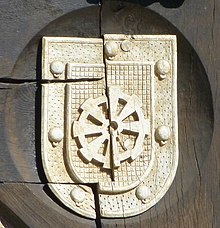Weber


On the lowest floor there are the flaps to the Dunke, the damp cellar where the weaving took place.
A weaver is a person who practices the craft of weaving as a profession . The weaver makes various fabrics from yarn .
Specialized Weber were the clothiers , the only fine milled and napped wool fabric , known as cloth , made has Leineweber produced exclusively canvas , silk weavers wove silk .
description
Widespread weaving yarns made from local raw materials were wool for cloth making, flax and hemp for linen weaving. In addition, imported raw materials such as cotton and silk were processed. In the Middle Ages , linen weaving was one of the "dishonest professions" .
The loom enabled the weaver to produce high quality fabrics . However, the mechanical looms and industrialization brought the end of this previously very widespread craft. This upheaval cost many weavers their existence. And so the weavers were one of the first professions to experience the negative consequences of industrialization first-hand. Gerhart Hauptmann presented this topic in the drama Die Weber .
In modern times , the vast majority of fabrics are produced industrially . The artisanal weaving is now operated more as a handicraft . In the Third World , however, many weavers still make a living with this craft at or below the poverty line . Also, child labor there in this profession not uncommon.
The patron saint of the weavers is Radegundis .
Technical training in the 21st century in Germany
Weber is a recognized training occupation according to the craft regulations . The dual training lasts three years and ends with the journeyman's examination. In addition, there is the opportunity to prepare for the journeyman's examination for four years outside the company in the weaver classes .
On January 1, 2004, the craft regulations in Germany were changed; The compulsory master craftsman for weaving companies has ceased and the weaving trade has become a trade that does not require a license . An authorization to train apprentices as part of the dual training is also possible from this date without a master craftsman's examination; the required professional qualification as a trainer is already given with the journeyman's examination. Only a trainer aptitude test has to be taken as proof of professional and work pedagogical suitability.
In Austria, weaving is one of three training opportunities in the three-year textile design apprenticeship.
Known weavers
Some of the most famous German weavers who created textile art
and other picture makers .
See also
- Silk weaver monument in Krefeld
- Machine striker
- History of the textile industry
- Weaver revolt
- Weber parable
- Drawweaver
Individual evidence
- ^ Anne-Marie Dubler : Textile Industry - Textile Industry and Textile Industry at a Glance. In: Historical Lexicon of Switzerland . October 7, 2014 , accessed June 4, 2019 .
- ↑ Meister Eckhart , handicraft: linen weaver
- ^ AG high Middle Ages : fabrics
Web links
- Medieval cloth production in Nuremberg at Foracheim
Weber in the appointment of the Federal Employment Agency

